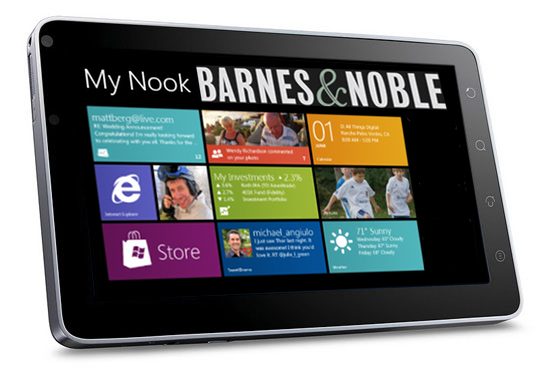Will Barnes & Noble and Nook usher in a $199 Windows Metro tablet?


The big news today is that Microsoft and Barnes & Noble have buried their respective litigious hatchets and as a result, Microsoft is going to invest in a $300M spin-off of B&N which is to include their NOOK products division as well as the company's higher education business.
Also Read:
- Microsoft & Barnes and Noble settle patent dispute; create new subsidiary
- Is there a Windows-based Barnes & Noble reader in the works?
Part of the nature of this spin-off, currently called "NewCo" is to produce an e-reader application written for the Windows 8 Metro interface, which will be used on new tablets and PCs running on the x86 and ARM architectures.
But what about e-reader and Nook Tablet devices themselves, running on a Metro-enabled version of Windows?
Back in NovemberI speculated about the possibility of 7", $199.00 tablets running the Windows Phone OS to compete with Amazon's Kindle Fire.
- Also Read: Microsoft, Where's your $199 Windows Tablet?
At the time, I felt that Microsoft had missed a huge opportunity in the 7" form factor, since they had an OS for the ARM architecture pretty much ready to go, with a app ecosystem developing for it well underway.
However, Microsoft along with this new joint venture with Barnes & Noble could very well make a run for Amazon's low-end tablet aspirations.
The question remains, however, if the price points could be kept agressive to compete realistically with Kindle Fire, if Microsoft and B&N can present a value-add that is comparable to what Amazon brings to the table with Prime, and if a sufficient amount of exploitive apps for Metro using a 7" form factor and corresponding screen resolution could be built quickly enough.
One of the reasons why NOOKTablet could remain relatively competitive with Kindle Fire was its use of the Android operating system, which did not require licensing. If the next-generation product is to be based on some version of Metro-enabled Windows, there is the issue of additional licensing cost for the OS that has to be built into the bill of materials for each device.
However, as Microsoft will be a partner in this new NOOK joint venture, one would presume that these licensing terms might be more generous than what the average Windows Phone or Windows 8 OEM is going to receive.
Beyond the licensing there is of course the adaptation and software fragmentation issues that currently plague Android that Windows 7 Phone OS is currently immune to. If a 7" form factor device is to be built, and it ends up running the next generation of Windows Phone OS (codenamed "Apollo") then it would have to support a higher screen resolution.
One of the reasons why Windows Phone 7 was never licensed to OEMs for anything other than producing smartphones was that they only supported a single screen resolution.
Back in February, my colleague, Mary Jo Foley, published a list of possible features that "Apollo" might support, based on information leaked from various sources on the Internet.
- Also Read: Windows Phone 8, What's on the feature list
The first five features, namely support for multiple processors, support for multiple screen resolutions, removable MicroSD card support, and inclusion of the Windows Core elements would seem to be essential for building a 7" tablet device.
While it has been widely reported that the first "Apollo" phones will be out in Q4 2012, we don't know if all of these features are actually going to appear in the finished OS.
The other possibility is to build the device on Windows RT, the ARM-based OS derivative of the full-blown Windows 8, formerly referred to as "Windows on ARM".
Also Read:
- Windows on ARM to launch simultaneously with Windows 8 on Intel
- Windows 8 consumer and Windows RT editions: What's missing?
While this OS is relatively closer to completion -- the first Windows RT devices are likely to appear around the fall of 2012 -- it would require more far more tweaking and likely require the creation of a special Windows SKU to build a 7" tablet for Barnes & Noble's new subsidiary.
Why? Well, the minimum specs for a Metro UI with snap support on Windows 8is a screen resolution of 1366x768. While it is definitely doable to produce a 7" device with such a screen resolution, it might be overkill and blow the BOM out of the water and prohibiting a product to be manufactured at a $199.00 price point.
So the Windows RT OS would have to be modified to have a "snapless" GUI and run at a lower screen resolution -- making it something of an inbred offshoot of Windows RT and Windows "Apollo". And of course, you'd have to rip out the "Desktop" along with the integrated Office apps which would add licensing cost, and which wouldn't work particularly well on such a small screen anyway.
All of which would introduce developer fragmentation, and a third Windows mobile SKU which nobody wants, especially Microsoft.
So all roads seem to lead to an "Apollo" based NOOK ereader tablet. When and if such a product actually emerges will be interesting to see, although we are probably looking at a six to eight month product development to launch time frame, at the bare minimum, in which case it will end up competing with Amazon's next-generation Kindle Fire.
Would you buy a $199 Windows Metro-based NOOK tablet? Talk Back and Let Me Know.